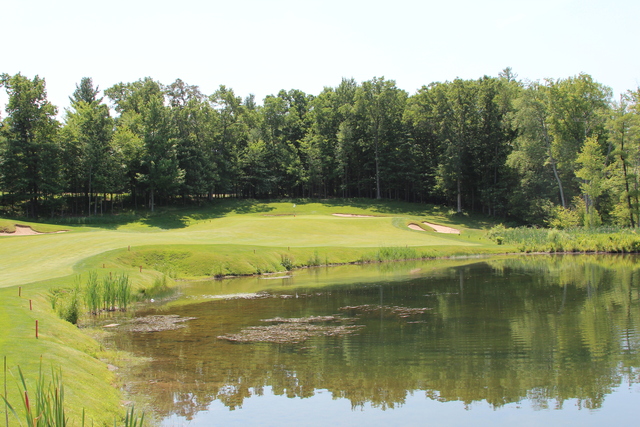World-ranked designs and high-profile restoration projects being recognized
Traverse City, MI - Mike DeVries, principal partner in DeVries Designs, Inc., a golf course design firm based in Traverse City, Mich., has project-by-project built a reputation as one of the leading minimalist architects of this generation.
In the most recent Golf Digest highlighting the best new courses, Architecture Editor Ron Whitten wrote about new courses focusing on “fun and playability” and that “they represent the trend that many architects are embracing: build for the masses, not the elite players.”
DeVries’ recent work on Cape Wickham Links on King Island, Tasmania, Australia, is evidence of Whitten’s declaration. The project made its debut in 2016 at No. 24 on Golf Digest’s World’s 100 Greatest Courses.
“Golf should be fun, isn’t that why we play?” DeVries asks. “If someone says they had fun playing a course I designed that is the highest compliment I can receive. At Cape Wickham, the weather is quite variable and the wind can really blow at times, so it was paramount that we employed very wide fairways to accommodate golfers of all skill levels.”
The design at Cape Wickham accommodates with significant amounts of short turf surrounding them and providing multiple shot and club options (putt, pitch, chip and run, flop, hybrid bump and run, etc.) for recovery play when golfers miss the green.
“The fun greens and fairway width enables playability in all conditions for everyone, yet strategy dictates certain angles to certain pins for optimal scoring – this challenges the best players to think their way around the golf course while permitting the average player to have fun playing all kinds of different shots,” DeVries said.
He worked with consultant and co-designer Darius Oliver to create a classic minimalist design that flows through spectacular dune areas and along the coastline of the Bass Strait. All 18 holes provide views of the ocean with eight holes running along the coast and offering some of the most spectacular golf views in the world. The view of the Cape Wickham Lighthouse next to the course draws comparisons to the view at Ireland’s Old Head.
The spectacular coastline at Cape Wickham is in fact so dramatic that it could have easily overshadowed the golf. It made the routing of the golf course the most important aspect of the design, and DeVries and Co. did not disappoint.
“Good routings have a rhythm to them that creates an ebb and flow to the round, with stretches of strong holes interspersed with some easier ones, lending balance to a course and psychologically challenging golfers to stay on task,” DeVries said. “It could be argued that the best golfing ground is away from the coast but we utilized that to full effect starting on the coast, going inland, back to the coast, inland, and finishing on the coast with a climactic hole along the beach.”
Whitten clearly agreed and eloquently penned in the 100 Greatest article that the routing at Cape Wickham is “heart-pounding, starting along rocks and crashing surf, moving inland but not out of the wind, returning to ocean edge at the downhill 10th, pitch-shot 11th and drivable par-4 12th, then wandering into dunes before a crescendo closing hole curving along Victoria Cove beach, which is in play at low tides.”
As for DeVries’ work on restoration projects, he leans on his expert knowledge of MacKenzie, Ross, Tillinghast, Raynor and other classic designers. It has helped him recently with wonderful restoration projects in the New York region at Sunningdale and Siwanoy.
“Siwanoy and Sunningdale have good ground, great original architects, and engaging memberships,” DeVries said. “Like many older clubs, they had lost some of their original design intentions through typical changes like tree planting, shrinking greens, irrigation, and well-intentioned but possibly ill-advised renovations, usually in the form of “modernizing” the course.”
DeVries was able to bring back the original intent of these classic courses by removing trees, expanding greens, remodeling tees, bunkers and fairway lines and upgrading irrigation to provide the strategy and fun shot-making that are the hallmarks of these courses from the early 20th century. DeVries feels those qualities are truly never out of style and, as a result, both are wonderful, fun courses to play every day.
With more than 35 years in the golf business, including growing up near and working on the renowned MacKenzie classic Crystal Downs in northern Michigan, DeVries has developed an impressive hands-on approach to creating minimalist designs, including shaping his own greens and bunkers, working with owners and construction teams to develop environmentally sensitive golf courses, and paying attention to the details with a “less is more” attitude of designing courses that fully integrate with the landscape.
His award-winning projects include the previously mentioned Cape Wickham, as well as Kingsley Club (#21), and Greywalls (#77) on Golfweek’s Top 100 Modern Courses in the USA.
His classic course restoration projects include Meadow Club (Alister MacKenzie), Siwanoy County Club (Donald Ross), Sunningdale County Club (Raynor, Travis, Tillinghast), St. Charles CC in Winnipeg, Manitoba (Ross/MacKenzie), Pelham Country Club (Devereux Emmet), and Jockey Club in Buenos Aires, Argentina (MacKenzie).









